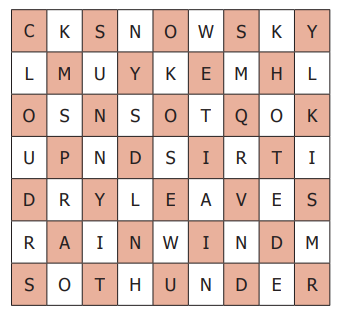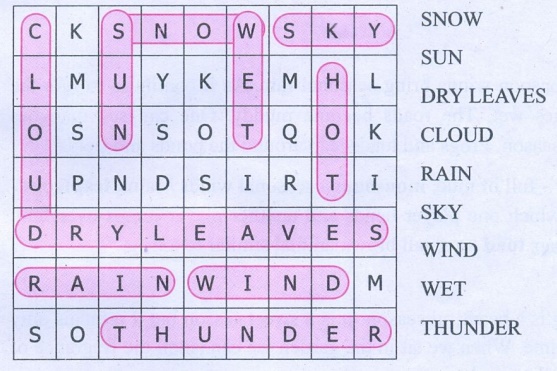English : Term 3 Unit 1 : Poem : Indian Seasons
WARM UP
Discuss in pairs, pck out the words related to seasons from the grid and write them in the blanks.


SNOW
SUN
DRY LEAVES
CLOUD
RAIN
SKY
WIND
WET
THUNDER

What day is it?
1. We feel thirsty on a Summer day.
2. We use an umbrella on a rainy day.
3. We sail paper boats on a rainy day.
4. We fly kites on a windy day.
A. Read the poem aloud in pairs.
B. Which season am I? Read the poem, understand and solve the riddle.
1. I make the feet dusty. Summer
2. Frogs and toads will visit when I am there. Rain
3. I am pretty short and sweet. Spring
4. I make your garden smell sweet. Spring
5. Leaves will wither because of me. Autumn
GLOSSARY
blaze – bright flame or fire
leap – to jump high
dusty – covered with tiny bits of sand
toad – a small brown animal similar to a frog
READ AND UNDERSTAND
C. Read the lines and answer the questions given below.
1. Summer comes
in a blaze of heat with
sunny smiles
and dusty feet
a. Does the poet welcome the summer? How do you know?
Yes, the poet welcomes summer because he talks about ‘sunny smiles’.
b. Which line tells you that there is no rain in summer?
The line ‘and dusty feet’ shows that there is no rain in summer.
2 . Spring is pretty
but short and sweet
when you can smell the grass
from your garden seat
a. How does the poet describe the spring season?
The spring season is pretty and sweet. But it stays for a short time.
b. Which line tells you that the garden is fresh?
When you can smell the grass from your garden seat
c. Who does ‘you’ refer to?
‘You’ refers to the person who owns the garden.
3. Autumn is English
in red, yellow and brown
Autumn is Indian
Whenever leaves fell down
a. How is autumn in India?
In India, autumn is marked by the falling down of leaves.
b. Compare the nglish autumn with the ndian autumn.
The English autumn shows change of colours. The leaves turn red, yellow and finally brown.
The Indian autumn marks the shedding of leaves.
D. pick out the rhyming words from the poem and write them in the table.
Stanza – 1 : heat / feet
Stanza – 2 : roads/toads
Stanza – 3 : sweet / seat
E. Find examples of alliteration and write them in the blanks.
1. in a blaze of heat
with sunny smiles
s unny / smiles
2. to muddy roads
monsoons and mangoes
muddy / monsoons / mangoes
3. Spring is pretty
but short and sweet
spring / short/ sweet
F. Work in pairs, find answers for the questions and share in the class.
1. Name the seasons mentioned in the poem?
Summer, Rain, Spring and Autumn are the seasons mentioned in the poem.
2. What does the summer bring?
Summer brings heat and dust.
3. Which word refers to ‘rain’?.
The word ‘monsoons’ refers to rain.
4. Why does the poet say the ‘ Spring is pretty’?
New leaves appear during spring. The tender leaves that appear make spring pretty.
5. When is it autumn in India? Why does the poet say this? Is there an autumn season in India?
There is autumn in India after summer. Autumn in India is different from autumn in England. So he says this. Yes, there is an autumn season in India.
G. How does the poet describe the Indian seasons? Write in your own words in about 50 words.
In the summer season the sun shines bright. There is heat and dust during this season. During rain the roads become muddy. Mangoes, frogs and toads are seen during this season. The spring season is short, sweet and pretty. There is a smell of grass. During autumn plants shed their leaves. In cold countries, leaves change colour during this season.














